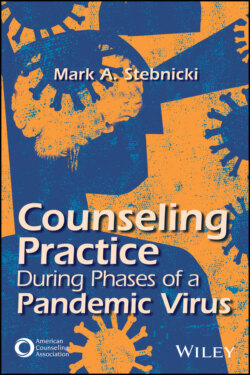Читать книгу Counseling Practice During Phases of a Pandemic Virus - Mark A. Stebnicki - Страница 10
Will There Be an End to the Coronavirus Pandemic?
ОглавлениеInfectious viruses and diseases have been with us since the beginning of time. They are a naturally occurring phenomenon. They can adapt and survive in a variety of conditions but must have a human and/ or animal host to exist in their virulent and highly contagious state. It may be that viruses inherit the earth (Tyson, 2007). So is there an end in sight to COVID-19? This is much like asking “How long will it take before the sun’s fuel burns out?” It is helpful to understand that there is no beginning or end to a viral contagion.
The journal Nature explores what the science says about how COVID-19 will play out in the months and years to come. Scientists indicate that for the pandemic to end, either COVID-19 must be eliminated from the global population (which is near impossible) or between 50% and 80% of the world’s population must build up sufficient immunity through either infections or vaccinations (Scudellari, 2020). Public health officials and infectious disease experts have said it is very likely that COVID-19 will become an endemic disease. Essentially this novel coronavirus will always be present in our environment with possible mutation in the human genome long after the government immunization program ends. If we are fortunate, COVID-19 will be classified as a low-level contagion. Thus, the medical, mental, and public health care systems as well as the world economy will have to learn how to survive this endemic virus.
The challenges in the COVID Generation are unlike any others. It would be naive to imagine that once the COVID-19 vaccines have been distributed and administered to most of the world’s population that a book such as this will no longer be relevant. In fact, rabies still exists today, despite Louis Pasteur’s development of a successful vaccine in 1885. Tetanus (vaccine developed in 1927), measles, mumps, and rubella (1971), hepatitis B (1982), and hepatitis A (1995) all have the potential to be public health crises in certain occupational settings and regions of the world despite the public perception that these diseases have been eradicated. Fortunately, the COVID-19 vaccines on the market have about 72–95% efficacy in treating COVID-19. However, we will need to continue collecting data on those who have been immunized given the new coronavirus variants.
The good news is that we are in a much better place now than Americans were during the 1918 H1N1 (Spanish flu) pandemic, when approximately 675,000 people in the United States died. The measures available in 1918 to mitigate the spread of a viral contagion were extremely limited. That pandemic predated antibiotics and did not involve epidemiology, highly specialized lab sciences for deciphering the genomes of infectious diseases, or the technology used today by the pharmaceutical industry in the research and development of vaccines. There were no diagnostic tests available to confirm infections and no antiviral medications that could significantly reduce symptoms of the virus. Thus, we have seen improvements coming out of the 20th century and into the 21st. This is evident by advancements in disease surveillance, diagnostic testing, situational awareness, community mitigation science, and a system of public health communication (Jester et al., 2018).
